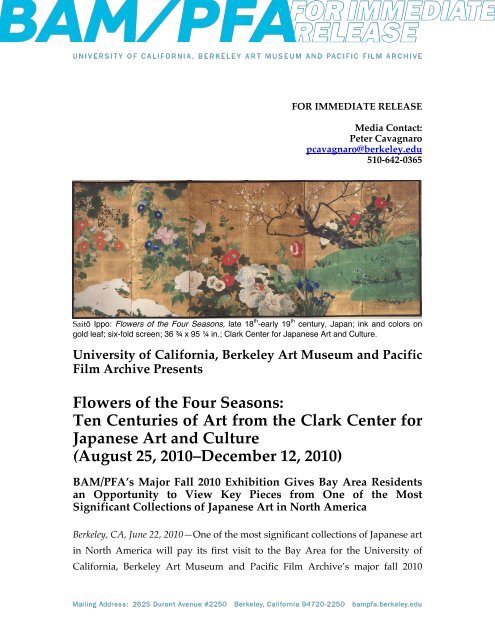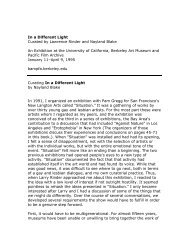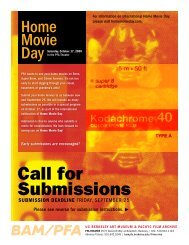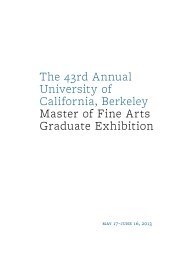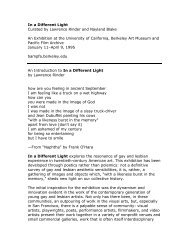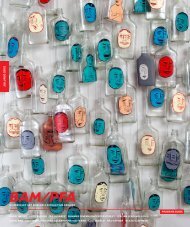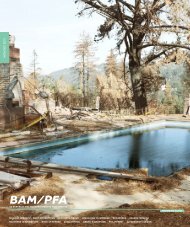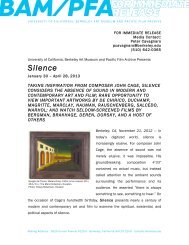Download a PDF version of this press release. - Berkeley Art ...
Download a PDF version of this press release. - Berkeley Art ...
Download a PDF version of this press release. - Berkeley Art ...
- No tags were found...
Create successful ePaper yourself
Turn your PDF publications into a flip-book with our unique Google optimized e-Paper software.
FOR IMMEDIATE RELEASEMedia Contact:Peter Cavagnaropcavagnaro@berkeley.edu510-642-0365Saitō Ippo: Flowers <strong>of</strong> the Four Seasons, late 18 th -early 19 th century, Japan; ink and colors ongold leaf; six-fold screen; 36 ¾ x 95 ¼ in.; Clark Center for Japanese <strong>Art</strong> and Culture.University <strong>of</strong> California, <strong>Berkeley</strong> <strong>Art</strong> Museum and PacificFilm Archive PresentsFlowers <strong>of</strong> the Four Seasons:Ten Centuries <strong>of</strong> <strong>Art</strong> from the Clark Center forJapanese <strong>Art</strong> and Culture(August 25, 2010–December 12, 2010)BAM/PFA’s Major Fall 2010 Exhibition Gives Bay Area Residentsan Opportunity to View Key Pieces from One <strong>of</strong> the MostSignificant Collections <strong>of</strong> Japanese <strong>Art</strong> in North America<strong>Berkeley</strong>, CA, June 22, 2010—One <strong>of</strong> the most significant collections <strong>of</strong> Japanese artin North America will pay its first visit to the Bay Area for the University <strong>of</strong>California, <strong>Berkeley</strong> <strong>Art</strong> Museum and Pacific Film Archive’s major fall 2010
exhibition, Flowers <strong>of</strong> the Four Seasons: Ten Centuries <strong>of</strong> <strong>Art</strong> from the ClarkCenter for Japanese <strong>Art</strong> and Culture. BAM/PFA will display over 110 works <strong>of</strong>art from the Clark Center <strong>of</strong> Hanford, California. The exhibition reflects thebroad collecting interests <strong>of</strong> the Center’s founder Willard G. Clark. His passionfor Japanese art and culture has resulted in a collection ranging from the lateHeian period (794–1185) to the twenty-first century, including all major areas <strong>of</strong>artistic endeavor—screens, scrolls, wood sculptures, textiles, ceramics, andworks <strong>of</strong> bamboo.Clark studied architecture at UC <strong>Berkeley</strong> and animal husbandry at UC Davis inthe early 1950s. He started his art collection with modestly priced purchases <strong>of</strong>art on his several visits to Japan from Hawai’i where he was stationed as a young<strong>of</strong>ficer in the United States Navy. After his <strong>release</strong> from the military in 1963, hetook charge <strong>of</strong> the family business, quintupled its size, and embarked on an evenmore successful venture exporting bull semen overseas. As Clark’s businessesgrew, so did the size and scope <strong>of</strong> his immense art collection. In 1995 he foundedthe Clark Center, a museum for Japanese art, to better protect these preciousworks and to make them available for public viewing. From 2002 to 2003highlights from the collection traveled to five cities in Japan, including Tokyoand Osaka, where they were admired by thousands <strong>of</strong> visitors. Given theCenter’s relative remoteness, too few in the United States have had a chance toview <strong>this</strong> important collection. The BAM/PFA exhibition will change <strong>this</strong> bypresenting to the public the most significant pieces from each <strong>of</strong> the key areas <strong>of</strong>the collection.Much <strong>of</strong> the Flowers <strong>of</strong> the Four Seasons exhibition comprises work from theEdo, or pre-modern, period (1603–1868). The hanging scrolls and folding screenson display portray a variety <strong>of</strong> subjects; playful images <strong>of</strong> urban life, the elegantdi<strong>version</strong>s <strong>of</strong> nobility, portraits <strong>of</strong> Buddha, natural and idealized landscapes,flora, birdlife, and other animals. The overall effect <strong>of</strong> <strong>this</strong> variety <strong>of</strong> imagery is aremarkable view <strong>of</strong> the artistic creativity in Edo Japan.
Wood and polychromy Buddhist sculptures, dating from the Heian period to theKamakura period (1185–1333), are the oldest pieces in the exhibition. Movingforward in time, a portion <strong>of</strong> the exhibition focuses on late-twentieth centurybamboo sculpture. Japanese farmers and artisans plaited bamboo for hundreds<strong>of</strong> years, but it wasn’t until the mid-twentieth century that bamboo began to bethought <strong>of</strong> as a sculptural medium in its own right. Flowers <strong>of</strong> the Four Seasonshighlights signature works <strong>of</strong> some <strong>of</strong> the most significant modern bamboosculptors including Ueno Masao, Mimura Chikuhō, Nagakura Ken’ichi, andUematsu Chikuyū. Contemporary artist Fukami Sueharu’s collection <strong>of</strong> lightblue ceramic sculptures, with sleek edges and s<strong>of</strong>tly contoured planes that evokesword blades or ocean waves, round out the exhibition and demonstrate thatClark’s interests encompass both the past and the future <strong>of</strong> Japanese art.The exhibition will be accompanied by public programs, including a lecture onAugust 26, 2010, by British scholar Timon Screech—Collecting and Viewing inthe Edo Period: Some Thoughts on the Ownership and Display <strong>of</strong> Paintings—and a series <strong>of</strong> four performance-based events presented in conjunction withBAM/PFA’s after hours program L@TE: Friday Nights @ BAM/PFA,programmed by Tomo Yasuda, a Bay Area-based Japanese-American electronicmusician.Flowers <strong>of</strong> the Four Seasons: Ten Centuries <strong>of</strong> <strong>Art</strong> from the Clark Center forJapanese <strong>Art</strong> and Culture is organized jointly by the <strong>Berkeley</strong> <strong>Art</strong> Museum andPacific Film Archive and the Clark Center for Japanese <strong>Art</strong> and Culture and is cocuratedby Julia M. White, senior curator for Asian <strong>Art</strong> at BAM/PFA andAndreas Marks, Clark Center director.CreditPublic programming for Flowers <strong>of</strong> the Four Seasons: Ten Centuries <strong>of</strong> <strong>Art</strong>from the Clark Center for Japanese <strong>Art</strong> and Culture is supported by Bonhams &
Butterfields, Bonhams Japanese <strong>Art</strong> North America, and the Metropolitan Centerfor Far Eastern <strong>Art</strong> Studies. Flowers <strong>of</strong> the Four Seasons has been made possiblein part by the Center for Japanese Studies, UC <strong>Berkeley</strong>.About BAM/PFAThe <strong>Berkeley</strong> <strong>Art</strong> Museum and Pacific Film Archive (BAM/PFA) is the visualarts center <strong>of</strong> the University <strong>of</strong> California, <strong>Berkeley</strong>, one <strong>of</strong> the nation’s leadingresearch universities. BAM/PFA aims to inspire the imagination and ignitecritical dialogue through contemporary and historical art and film, engagingaudiences from the campus, Bay Area community, and beyond. One <strong>of</strong> thelargest university art museums in the United States in both size and attendance,BAM/PFA presents fifteen art exhibitions and five hundred film programs eachyear. The museum’s collection <strong>of</strong> more than 15,000 works, distinguished byartistic excellence and innovation, intellectual exploration, and socialcommentary, includes exceptional examples <strong>of</strong> mid-twentieth-century painting,including important works by Hans H<strong>of</strong>mann, Jackson Pollock, Eva Hesse, andMark Rothko, as well as historical and contemporary Asian art, early Americanpainting, Conceptual and contemporary international art, and California and BayArea art. The PFA film and video collection now includes the largest group <strong>of</strong>Japanese films outside <strong>of</strong> Japan, as well as im<strong>press</strong>ive holdings <strong>of</strong> Soviet silents,West Coast avant-garde cinema, seminal video art, rare animation, Central Asianproductions, Eastern European cinema, and international classics.Museum InformationLocation: 2626 Bancr<strong>of</strong>t Way, just below College Avenue near the UC <strong>Berkeley</strong>campus.Gallery and Museum Store Hours: Wednesday through Sunday, 11–5. OpenL@TE Fridays until 9 p.m. Closed Monday and Tuesday.Admission: General admission is $8 ($10 beginning September 1, 2010);
admission for seniors, disabled persons, non–UC <strong>Berkeley</strong> students, and youngadults (13 – 17) is $5 ($7 beginning September 1, 2010); admission for BAM/PFAmembers, UC <strong>Berkeley</strong> students, staff, and faculty, and children under 12 is free.Reservations are required for group visits; for information, rates, and schedule,please e-mail sgvisits@berkeley.edu. Admission is free on the first Thursday <strong>of</strong>each month.L@TE Admission: On L@TE Fridays, general admission to the BAM galleries is$5 after 5 p.m. ($7 beginning September 1, 2010). Show your ticket for a same-dayPFA screening or gallery visit and get in free. Admission is always free forBAM/PFA members and UC <strong>Berkeley</strong> students, faculty, and staff. For updateson L@TE programs and to purchase tickets, visit bampfa.berkeley.edu/late.Information: 24-hour recorded message (510) 642-0808; fax (510) 642-4889; TDD(510) 642-8734.Website: bampfa.berkeley.edu# # #Please note: For a selection <strong>of</strong> media images, please contact Peter Cavagnaro at(510) 642-0365 or pcavagnaro@berkeley.edu.


